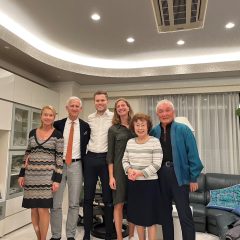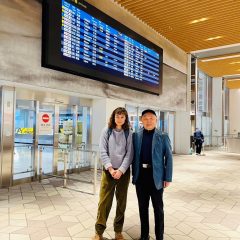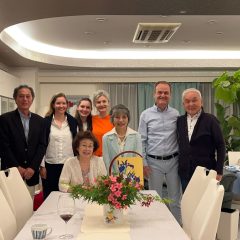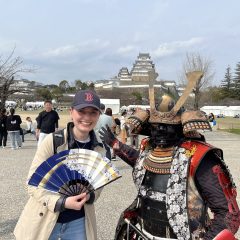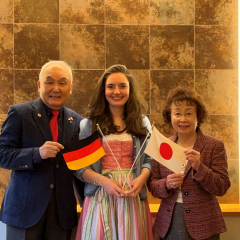☆☆☆ Last report from Christina Neumayer, twentieth scholar of the Grünwald foundation ☆☆☆
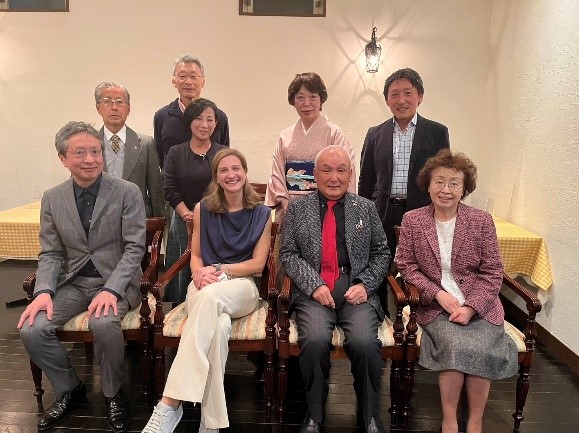
I decided to use the last two weeks of my stay in Japan to visit my favourite places one last time (and at best discover something new) and to say goodbye to my friends who accompanied me for the last three months and made my stay unique with wonderful shared experiences.
In addition, thanks to Mr Okamoto, I got even more unique opportunities to explore and get to know the country of Japan. For example, he invited me to eat sushi with his wife. We ate many different kinds of fish and three different kinds of tuna. I also tried the very famous crabs called Kobako from the Japanese sea, these are only available for 3 months of the year, November to January, and also only very rarely, because the population must not be endangered. A real delicacy!
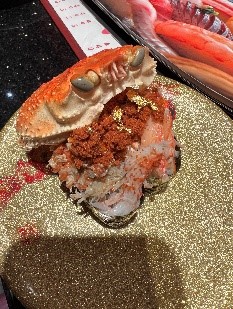 Kobako crab
Kobako crab
With the help of his Rotary colleagues, Mr Okamoto also organised a visit to the pharmaceutical company Taikou Yakuhin Pharmaceuticals, which is particularly known for the drug Seirogan. After a 2-hour company presentation by CEO Hitoshi Shibata, we had lunch together and also go to Nara County to a production site. It was very exciting to gain an insight into the factory of a Japanese pharmaceutical company and to experience the assembly line work at first hand.
I also took advantage of the last few days to enjoy a sunrise (in the land of the rising sun) and went with my friend Nami to Minoh (about an hour north of Osaka, this forested region is a charming retreat from the hustle and bustle of the city). I had previously met Nami on a delayed (!) train journey, as she was showing me alternative routes for the train journey. We started talking and decided to go on a hiking trip together. Having lived and worked in the US for a year, Nami speaks fluent English and exudes an enormous openness to meeting new people. From Mino-o station we walked through narrow and beautiful alleys including great autumn leaves to Mino Waterfall. On the way, we tried autumn leaf tempura (momoji tempura), the autumn leaves of the trees deep-fried in sweet batter, very tasty (oishii!).
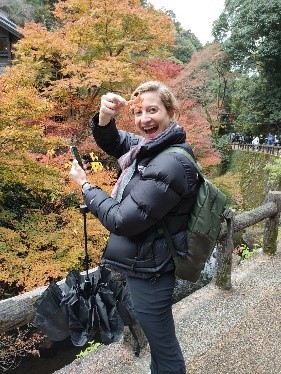 Momoji-Tempura
Momoji-Tempura
Afterwards, we took the bus to Katsuo-ji Temple. Great panoramic views, a mist-shrouded bridge over koi fish ponds, a tin-red pagoda and Daruma dolls (Japan’s symbol of luck) everywhere characterise the area. Known as the “Temple of Victorious Luck” or “Temple that Wins Against Monarchs”, spoken prayers here have healed emperors and helped shoguns win many conquests. Attracted by the spiritual tranquillity of this mountain region, the Buddhist priests Zenchu and Zensan first built a small hut here in 727. Myokan, a Buddhist monk known as the incarnation of Kannon Bosatsu, the goddess of mercy, crafted a tall sandalwood statue of Kannon with eleven faces and 1,000 hands. This became the main deity of the temple. It was believed that the prayers offered here helped Emperor Seiwa to recover, who then named the temple “Katsuo-ji”, meaning “the temple that helps to triumph”. The consistent faith attracted many followers, and today people gather here to pray for victorious luck in work, study, business, sports and virtually any endeavour. The fascinating thing about Katsuo-ji is that the temple and its grounds are littered with countless Daruma dolls hidden in every nook and cranny. The red wooden dolls were modelled on the founder of Zen Buddhism, who apparently sat in meditation for so long that his arms and legs fell off! Hence the round shape of the dolls. The ones in this temple are called kachi daruma (winning daruma). It was a wonderful day with good conversations, great weather, lots of nature and fresh autumn air. I will miss such excursions and interactions.
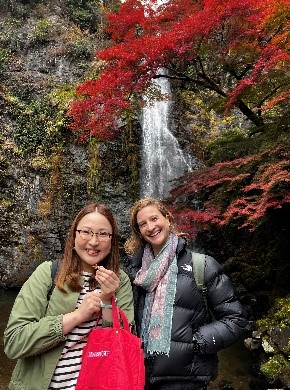 With Nami
With Nami
I also went to Kyoto one last time and visited the Eikando Zenrin-ji temple to enjoy the autumn leaves and to visit another Shingon Buddhist building. Built in the early Heian period (853 AD), the temple was considered a training ground for Shingon Buddhism. The temple complex is beautiful with a very large garden and many trees glowing in autumn colours – a great ending.

 Kyoto Eikando-Zenrin-ji temple
Kyoto Eikando-Zenrin-ji temple
And that’s the end of my stay in Japan. Actually, I don’t like saying goodbye at all. But when you have met such wonderful people with whom you share unique experiences, saying goodbye serves to deepen and strengthen the relationship so that you can meet again as soon as possible. And that is exactly what I did in my last days.
Mr Okamoto organised a wonderful evening with his (and by now my) friends. We had enough time to review our common experiences and to say goodbye heartily once again. The farewell party with Mr & Mrs Aoji, Mr Fukuda, Mr Bessho, Ms Wada, Toshisan and Mr and Mrs Okamoto was very beautiful and the memories shared will forever have a place in my heart.
 Farewell party (organised by Herrn Okamoto)
Farewell party (organised by Herrn Okamoto)
Unfortunately, it was also time to say goodbye to my Japanese and German/Austrian friends (Takuto, Sada, Toshi, Elena and Alina) from the DZGO (German language school). We enjoyed a highly cultural evening, with Japanese sweets, beer and Japanese and German songs, which we sang along loudly together as karaoke. Every time we met, we had a lot of fun, because precisely because we come from different cultures but have a great interest in each other, we were able to learn a lot of new things and especially give free rein to our cultural idiosyncrasies. I will miss it.
 Farewell at DZGO
Farewell at DZGO
After spending some time with the students of Kyoto Prefectural University (KPU) as well, I was also invited to a farewell party at the German teacher Mr. Aoji’s house. We ate sushi and Reina and Miyu played the song Sanpo from my neighbour Totoro, (one of the most famous anime in Japan from 1988 – highly recommended!) on flute and piano. We also sang the bird wedding song together. Very funny and beautiful evening.
 Farewell with KPU
Farewell with KPU
With a suitcase full of gifts that I received from all the dear people, I am now travelling back to Munich with one laughing eye and one crying eye. Of course I would have liked to stay much longer, but as we all know, you have to stop when it’s best. And the last few days are the reason why one eye is smiling: I became aware of all the unique people I had the chance to meet and the wonderful experiences I was able to have that will stay in my memory forever. During my stay, I not only got to know a new culture and new people, but especially gained new perspectives that are indispensable for intercultural understanding. Such experiences are very important for the future of our planet and for mutual understanding and international cooperation, and I hope that many more scholarship holders will have this opportunity. Furthermore, I have developed personally and learned to adapt to any situation, no matter how unfamiliar it may be. The last three months will help me to find a quicker and more creative approach to future challenges.
Therefore, I would like to express my heartfelt thanks to all those involved in this three-month stay in Japan. First and foremost, Mr. Okamoto and his wife, who were always there for me with their dedication and effort and opened all doors for me. Without them, I would never have met so many people, nor would I have gained such deep cultural insights. It is unique with what joy and enthusiasm Mr Okamoto promotes intercultural exchange. Thank you.
Great thanks also go to Mr. Okamoto’s friends, acquaintances from the German-Japanese society as well as the people from the DZGO and the KPU. I would also like to thank all those involved in the Grünwald Foundation and the Rotary Club Grünwald. The experiences I have had through the Grünwald Fellowship are unique and will leave a lasting impression on me. I look forward to seeing you again, in Japan, Germany or anywhere else on this wonderful, culturally diverse planet.
さようなら
Christina

